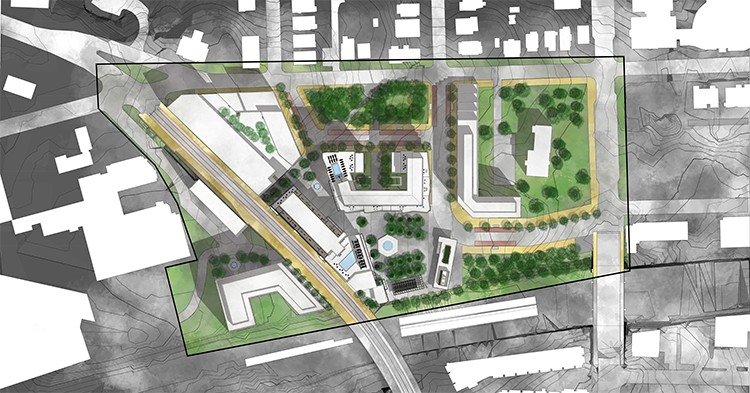
(Photo: Masterplan by Matthew Brown and Dylan Stefans)
Students enrolled in the Master of Architecture program, as well as those in the Master of Architectural Studies program, pursue a concentration in one of five areas.
The Urban Practice Concentration aligns with the aims and goals of the university in seeking to serve the needs of human society through the study the built environment of communities, neighborhoods, towns, and cities. Students in this concentration examine architecture in the way it contributes to the larger urban spatial condition and context, offering the opportunity to develop understanding and skills in urban design to enhance the social and environmental performance of building design.
Urban Practice: Preparing Urban Thinkers and Practitioners:
Urban design is widely recognised across the global academic community as a critical design and research discipline that has significant impact on community health, individual wellbeing, community resilience, and social, economic and environmental sustainability. This concentration presents students with this broad array of issues that contextualize architectural design thinking, emphasizing larger questions regarding spatial relationships, hierarchy, distinction of public and private, connectivity and proximity, landscape and hardscape. Inquiry through observation is a key method of study of urban places, using the observations of Jane Jacobs as the springboard for site investigations and historical and theoretical research.
Design Studio and Course Work:
The offering of this design discipline as an integrated and immersive pedagogy in a school of architecture adds value to the students’ development of problem solving skills. The Urban Design Methods and Analysis course engages students in research and analysis of urban structures in varying global contexts. Theory and history courses study the development of urban morphology across diverse world cultures. The Urban Design Studios then present the opportunity to apply knowledge and methods of analysis and design to address the many layers of challenges raised by projects ranging from urban infill to the design of new neighborhoods and towns. The integrated urban design/architectural pedagogy of this concentration provides a foundation for rigorous research in the development of the graduate thesis. This research will position graduates for a wide range of employment and academic opportunities.
Studying in Contexts: Here and Abroad
Washington DC and its environs' urban design and architectural excellence, international and national institutions and its large community of design firms, provide an exceptional context within which to study and work. Catholic University’s location also allows students to travel easily to cities in the United States and abroad, including opportunities for study in Rome and London.
